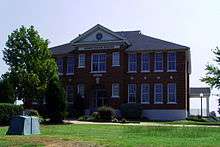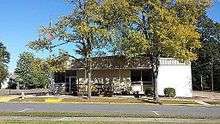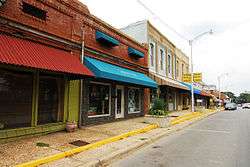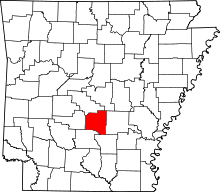Sheridan, Arkansas
| Sheridan, Arkansas | |
|---|---|
| City | |
|
Downtown Sheridan in 2011 | |
 Location in Grant County and the state of Arkansas | |
| Coordinates: 34°18′30″N 92°24′13″W / 34.30833°N 92.40361°WCoordinates: 34°18′30″N 92°24′13″W / 34.30833°N 92.40361°W | |
| Country | United States |
| State | Arkansas |
| County | Grant |
| Incorporated | August 26, 1887 |
| Government | |
| • Type | Mayor–council government |
| • Mayor | Joe C. Wise, Jr. |
| Area | |
| • Total | 12.1 sq mi (31.4 km2) |
| • Land | 12.1 sq mi (31.4 km2) |
| • Water | 0 sq mi (0 km2) |
| Elevation | 278 ft (84 m) |
| Population (2010) | |
| • Total | 4,603 |
| • Density | 379/sq mi (146.4/km2) |
| Time zone | Central (CST) (UTC-6) |
| • Summer (DST) | CDT (UTC-5) |
| ZIP code | 72150 |
| Area code(s) | 870 |
| FIPS code | 05-63710 |
| GNIS feature ID | 0054764 |
| Website |
www |
Sheridan is a city and county seat of Grant County, Arkansas. The community is located deep in the forests of the Arkansas Timberlands. It sits at the intersection of US Highway 270 and US Highway 167. Early settlers were drawn to the area by the native timber, which is still a very important part of Sheridan's economy, although the city has diversified into several other industries. Sheridan's history also includes a college, Missionary Baptist College, until its closure in 1934, and a series of civil rights conflicts.[1] Located at the southern end of the Little Rock-North Little Rock-Conway, AR Metropolitan Statistical Area, Sheridan has been experiencing a population boom in recent years, as indicated by a 49% growth in population between the 1990 and 2010 censuses.[2] The population as of the 2010 census was 4,603.[3]
History
Eponym
Sheridan was named after Union general Phillip Sheridan during the Reconstruction Era.[1]
Settlement through the Gilded Age
The first white settler was Dr. Richard C. Rhodes, a native of North Carolina.[1]
At the beginning of the 20th century, a railroad passed through Sheridan south into Dallas County. The railroad, owned by E. S. McCarty, carried freight and passengers for hire.[4]
From 1917 to 1934, Missionary Baptist College operated in Sheridan. The college suffered from financial troubles due to the Great Depression. The college provided local residents with courses, not only in theology, but in Latin, Greek, physiology, ecclesiology, and expression. A 1920 bulletin issued by the college wrote that its goal was "to teach and emphasize the very principles for which the real Baptists of Arkansas stand and for which true Baptists have stood for almost nineteen centuries . . . this is no preacher manufacturing establishment [that] the Lord alone has the prerogative of calling men to preach the gospel."[5] The revamped Missionary Baptist Seminary[6] thereafter opened in Little Rock.
Mid-twentieth century
In 1943, Jewell Williams, a Jehovah's Witness, was convicted in the Mayor's Court for selling Bibles without a permit under Sheridan City Ord. No. 50. and fined $10. On a trial de novo, he obtained the same result. Williams joined other members of his faith and appealed similar convictions occurring across the state to the Arkansas Supreme Court in Berry v. City of Hope, challenging the city ordinance as unconstitutional under the First Amendment. The court agreed and held the ordinances unconstitutional.[7]
The "Mighty 1090" KAAY radio station sponsored the Rebel Springs Rock Festival of 1973 5 miles (8 km) east of Sheridan on Highway 270 that included ZZ Top as a headliner. Tickets were $4 before the show and lasted three days, July 4–6, 1973. The National Guard was sent out to maintain "peace". Local property owners attempted to get a court-ordered injunction to halt the festival from talking place, on the legal theory of nuisance, but to no avail.[8]
Demographics
| Historical population | |||
|---|---|---|---|
| Census | Pop. | %± | |
| 1880 | 42 | — | |
| 1890 | 184 | 338.1% | |
| 1900 | 210 | 14.1% | |
| 1910 | 481 | 129.0% | |
| 1920 | 695 | 44.5% | |
| 1930 | 1,590 | 128.8% | |
| 1940 | 1,338 | −15.8% | |
| 1950 | 1,893 | 41.5% | |
| 1960 | 1,938 | 2.4% | |
| 1970 | 2,480 | 28.0% | |
| 1980 | 3,042 | 22.7% | |
| 1990 | 3,098 | 1.8% | |
| 2000 | 3,872 | 25.0% | |
| 2010 | 4,603 | 18.9% | |
| Est. 2015 | 4,812 | [9] | 4.5% |
Sheridan is part of the Little Rock–North Little Rock–Conway Metropolitan Statistical Area.
2010 census
As of the 2010 United States census[11] of 2010, there were 4,603 people, 1,841 households, and 1,238 families residing in the city. The population density was 1150.8 people per square mile (444.3/km²). There were 2,007 housing units at an average density of 501.8 per square mile (193.7/km²). The racial makeup of the city was 95.0% White, 1.6% Black or African American, 0.4% Native American, 0.5% Asian, 1.3% from other races, and 1.2% from two or more races. 2.8% of the population were Hispanic or Latino of any race. There were 1,841 households out of which 32.7% had children under the age of 18 living with them, 49.0% were married couples living together, 13.2% had a female householder with no husband present, and 31.8% were non-families. 27.5% of all households were made up of individuals and 12.2% had someone living alone who was 65 years of age or older. The average household size was 2.46 and the average family size was 2.98.
In the city the population was spread out with 25.2% under the age of 18, 9.1% from 18 to 24, 33.7% from 25 to 44, 16.9% from 45 to 64, and 15.1% who were 65 years of age or older. The median age was 36.6 years. The gender makeup of the city was 49.6% male and 50.4% female.
The median income for a household in the city was $57,305, and the median income for a family was $64,123. Males had a median income of $46,438 versus $31,580 for females. The per capita income for the city was $23,969. About 3.8% of families and 8.1% of the population were below the poverty line, including 3.8% of those under age 18 and 11.7% of those age 65 or over.
2000 census
As of the 2000 United States Census,[12] there were 3,872 people, 1,509 households, and 1,050 families residing in the city. The population density was 978.8 people per square mile (377.5/km²). There were 1,685 housing units at an average density of 426.0 per square mile (164.3/km²). The racial makeup of the city was 97.34% White, 0.96% Black or African American, 0.28% Native American, 0.15% Asian, 0.05% Pacific Islander, 0.57% from other races, and 0.65% from two or more races. 0.96% of the population were Hispanic or Latino of any race. There were 1,509 households out of which 35.4% had children under the age of 18 living with them, 56.4% were married couples living together, 10.4% had a female householder with no husband present, and 30.4% were non-families. 27.0% of all households were made up of individuals and 10.9% had someone living alone who was 65 years of age or older. The average household size was 2.49 and the average family size was 3.02.
In the city the population was spread out with 26.3% under the age of 18, 8.6% from 18 to 24, 30.6% from 25 to 44, 20.9% from 45 to 64, and 13.6% who were 65 years of age or older. The median age was 35 years. For every 100 females there were 90.7 males. For every 100 females age 18 and over, there were 91.0 males.
The median income for a household in the city was $37,207, and the median income for a family was $43,953. Males had a median income of $32,216 versus $22,891 for females. The per capita income for the city was $19,184. About 7.0% of families and 9.8% of the population were below the poverty line, including 11.3% of those under age 18 and 17.6% of those age 65 or over.
Education

Sheridan is provided public education from the Sheridan School District, including the Sheridan High School.
Sheridan had a segregated school for African-Americans until the Brown v. Board decision. At the time, Sheridan had around 199 African American residents out of the town's total population of 1,898. On May 21, 1954, the local school board voted unanimously to integrate its 21 African-American students into its high school to avoid the $4,000 it would have cost the school board to send them to Jefferson County. The white parents became upset and called another vote the next night. At that vote, the board voted unanimously to keep the local school segregated. Community members in the area, still not happy, petitioned and forced four school board members to step down.[13]
Next, the largest employer of African-Americans in the area offered to move the black families outside of Grant County to Malvern, at the employer's own expense, or to burn their houses down. After the departure of the last African-American student from the city limits, the city bulldozed the African-American school; the remnants of the school were buried and the city no longer had a duty to integrate their schools.[14]
In March 2014, Sheridan High School principal Rodney Williams ordered the removal of student profiles from the student yearbook, rather than publish one of an openly gay student. In response, a human rights organization held a rally on the State Capitol steps, and the principal received a petition with 30,000 signatures asking Williams to reverse the decision.[15]
Arts and culture

Sheridan hosts an annual event based on the area's deep roots in the timber industry called Timberfest,[16] which includes a lumberjack competition and live music around the courthouse square. The White River Kid, starring Antonio Banderas and Randy Travis, was filmed during a mock Timberfest during the summer of 1998, with many of the local residents appearing as extras.[17][18]
Tourism

The Grant County Museum, located on Shackleford Road in Sheridan, preserves and interprets the history and culture of the county for residents and visitors. The museum features exhibits detailing the Battle of Jenkins' Ferry, a segment of the Union's failed Red River Campaign during the Civil War, as well as a large World War II vehicle collection. Other exhibits include pioneer life and settlement in Grant County, and the flora and fauna native to the county. The Heritage Square is also on the museum grounds, featuring ten relocated and restored buildings.
Media
Bales and Cleveland started the first newspaper in the Grant County area, titled The Sheridan Spy. The first issue was dated September 1, 1881. In 1882, the Hon. J.S. Williams, who a year later became a state senator, bought the Sheridan Spy and renamed it The Sheridan Headlight, which is still published today. The short lived Grant County News was started in 1916 by William GoForth.[19]
Utilities

Sheridan's water system began when a private entity began installing water lines in the 1930s. This system was eventually purchased by the city, which now allows the Sheridan Water and Sewer Department to operate the system independently of city funds.[1] Today, Sheridan is capable of treating groundwater obtained from five wells at a rate of 4.5 million gallons (17 million liters) per day (MGD/MLD). Sheridan's wastewater treatment facility is located at the end of Gatzke Drive and discharges treated effluent to Big Creek in accordance with the permit granted by the Arkansas Department of Environmental Quality.[20] The facility utilizes a three-cell pond stabilization system followed by a holding pond and is designed for a flow of 0.67 MGD (2.5 MLD).
Notable people
- Ken Bragg, Republican member of the Arkansas House of Representatives from Sheridan since 2013
- David Delano Glover, United States representative for Arkansas's 6th congressional district from 1929 to 1935
- Robert W. Glover, Baptist pastor and politician
- Ray Hamilton, football player who played defensive end in the National Football League from 1938 to 1947, inducted into the Arkansas Sports Hall of Fame
- Andy Mayberry, member of the Arkansas House of Representatives from District 27, author of state law banning abortion after twenty weeks of gestation; born in Sheridan in 1970
- John Little McClellan, lawyer and politician, United States representative for Arkansas's 6th congressional district from 1935 to 1939
- Earl Smith, baseball player who played catcher in the Major Leagues from 1919 to 1930
- Eddie Joe Williams, State Senate Majority Leader, formerly mayor of Cabot, Arkansas
References
- 1 2 3 4 McClain, Millie J. (December 31, 2013). "Sheridan (Grant County)". Encyclopedia of Arkansas History and Culture. Butler Center for Arkansas Studies at the Central Arkansas Library System. Retrieved February 10, 2014.
- ↑ "Find a County". National Association of Counties. Retrieved 2011-06-07.
- ↑ "Geographic Identifiers: 2010 Demographic Profile Data (G001): Sheridan city, Arkansas". U.S. Census Bureau, American Factfinder. Retrieved November 10, 2016.
- ↑ McCarty v. Nelson, 195 S.W. 689, 691 (Ark. 1917).
- ↑ Goolsby, Elwin (April 1991). "The Rise and Fall of the Missionary Baptist College". GRASSROOTS - Journal of the Grant County Museum. Retrieved 3 June 2012.
- ↑
- ↑ "Berry v. Hope". Arkansas Supreme Court. Retrieved 19 May 2012.
- ↑ http://mighty1090kaay.blogspot.com/2010/08/rebel-springs-rock-festival-73.html
- ↑ "Annual Estimates of the Resident Population for Incorporated Places: April 1, 2010 to July 1, 2015". Retrieved July 2, 2016.
- ↑ "Census of Population and Housing". Census.gov. Retrieved June 4, 2015.
- ↑ "American FactFinder". United States Census Bureau. Retrieved 2011-05-14.
- ↑ "American FactFinder". United States Census Bureau. Retrieved 2008-01-31.
- ↑ Kirk, John, "Not Quite Black and White: School Desegregation in Arkansas, 1954-1966." 2011
- ↑ "A Minister Recalls The Pain Of Segregation." National Public Radio. Retrieved on February 24, 2009.
- ↑ http://www.cnn.com/2014/03/19/us/arkansas-gay-student-yearbook/index.html?hpt=hp_t2
- ↑
- ↑ "The White River Kid Movie". Encyclopedia of Arkansas. Retrieved 2013-07-10.
- ↑ IMDB entry
- ↑ Fredrick William Allsopp, "History of the Arkansas Press for a Hundred Years or More." 1922
- ↑ "Sheridan Wastewater Treatment Facility" (PDF). NPDES Permit AR0034347. Arkansas Department of Environmental Quality. Retrieved February 10, 2014.
External links
| Wikimedia Commons has media related to Sheridan, Arkansas. |

